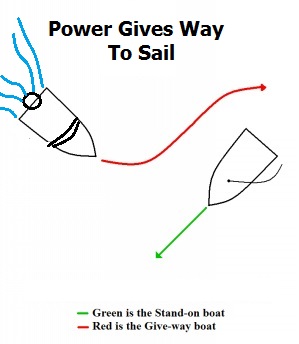Understanding navigational rules or Colregs (Collision Regulations) and knowing which is the stand-on boat or which is the give-way boat, is essential to learning how to sail. Colregs are largely based on the principle that the more maneuverable boat should keep out of the way of the less maneuverable boat.
Colregs can be broken down into three parts:
- rules of navigation between sailboats;
- rules of navigation between sailboats and powerboats (includes sailboats under power);
- rules of navigation between power boats.
The term ‘right-of-way’ does not apply to watercraft. Instead, a boat is either the stand-on boat or the give-way boat. The stand-on boat is required to maintain it’s course and speed. The give-way boat must stay clear of the stand-on boat. If a give-way boat is approaching a stand-on boat, the give-way boat must notify the stand-on boat of it’s intentions by making a clear and decisive change in course or speed.
In determining whether you are the stand-on or give-way boat go through the following process:
- Are you on a sailboat or a power boat (includes a sailboat under power)?
- Is the other boat a sailboat or a power boat (includes a sailboat under power)?
- If you are both on sailboats, what tack are you on and what tack is the other boat on?
- If you are both on sailboats and both on the same tack, which boat is closest to the wind?
Power Boats Give-Way to Sailboats
Are you operating a Sailboat (under sail) or a Power boat? Is the other boat a Sailboat (under sail) or a Power boat?
Power boats, as a general rule, must give way to sailboats.
If you are a power boat and the other boat is a sailboat under sail, you must give way. Alternatively, if you are a Sailboat under sail and the other boat is a power boat, then you are the stand-on boat.
There are however, a few exceptions:
- vessels not in command (i.e. not under control);
- where it is too difficult for a large power boat to navigate in a small channel;
- where the powered vessel, due to its size, has difficulty in navigating at the best of time;
- vessels engaged in fishing.
As a general principle, stay well clear of large powered vessels; they have difficulty in maneuvering, they may not see you and you could capsize in the wash.
Rules for Sailboats
Port Gives-way to Starboard
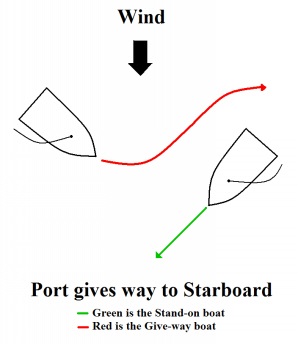
What tack is the other sailboat on and what tack are you on?
If you and the other boat are sailboats (under sail), this is the first factor you must determine.
The Colreg rule is that the sailboat on a Port Tack must give-way to the sailboat on the Starboard Tack.
If you and the other sailboat are on different tacks, then the boat on the port tack gives way to the boat on the starboard tack.
No consideration of which boat is windward is required.
Same Tack – Windward Gives-way

If you are on the same tack as the other sailboat, which boat is windward?
The Colreg rule is that the sailboat closest to the wind windward (upwind) sailboat must give-way to the leeward (downwind) sailboat.
As a cautionary note, the windward sailboat’s downwind vision is likely impaired by it’s sails. Even though you may be the leeward sailboat (stand-on), never assume that the windward boat can see you.
Remember, this Colreg rule only applies if boats are on the same tack. If boats are on opposite tacks then the ‘port gives-way to starboard’ Colreg takes precedence.
Uncertain Tack – Must Give-way
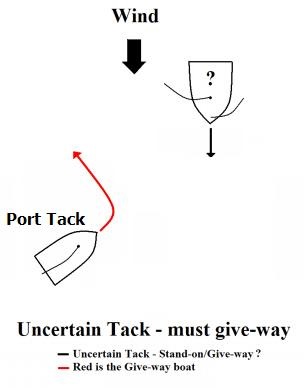
In some situations it is difficult to tell which tack the windward boat is on.
The Colregs state that if you are on a port tack and unable to determine the tack of a windward boat, then you are to assume that you are the give-way boat.
Why port tack? If the leeward boat was on a starboard tack, the windward boat would give way to the downwind boat, no matter what tack the windward boat was on (port gives way to starboard).
If the leeward boat was on a port tack and the windward boat also on a port tack then the windward boat gives way to the leeward boat (boats on the same tack – windward gives way to leeward).
However, if the windward boat is on a starboard tack then the leeward boat on a port tack must give way (port gives way to starboard).
This gives two different scenarios when the leeward boat is on a port tack. In one situation the leeward boat is the stand on vessel and in the other situation the leeward boat is give way vessel.
If the leeward boat was on a starboard tack then the windward boat would be the give way boat no matter which tack the windward vessel was on (port gives way to starboard or same tack – windward gives way to leeward).
Which tack the windward boat is on is only important if the leeward boat is on a port tack.
Where the leeward boat is uncertain which tack the windward boat in on, then rather than guessing which is the stand-on or give-way the colregs require the leeward vessel to assume that it is the give way vessel.
Overtaking a Slower Boat
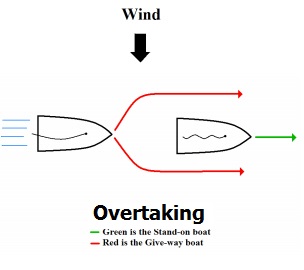
When wanting to pass a slower boat headed in the same direction you have the option of passing the boat on either your port or starboard side.
Colregs require the exercise caution when passing. It is important that no oncoming boats, water depth or width of channel will impede your ability to pass. You must pass at a safe distance from the boat being passed.
The boat being passed is always the stand-on vessel whether it is a sailboat or power boat. The boat being passed must not alter it’s course or speed.
Always indicate your intention to pass and the side you intend to pass on. This is where the proper use of sound signals becomes important.
If an overtaking vessel wishes to pass a vessel on the starboard side then it should sound 1 prolonged blast (4 to 6 seconds). If the vessel being overtaken is in agreement, it need not respond. If the vessel being overtaken disagrees with the intended action, it must sound 5 short (1 second) blasts -the danger signal.
Alternatively, if an overtaking vessel wishes to pass a vessel on the port side, then it should sound 2 prolonged blasts. If the vessel being overtaken is in agreement, it need not respond. If the overtaking vessel disagrees with the intended action, it must sound 5 short blasts – the danger signal.
Rules for Power Boats
Power Boats Meeting Head On
When two power boats (includes sailboats under power) are approaching each other from opposite directions (head-on), like driving a car (in North America), you pass to the right hand side. In our diagram, vessels A & B pass port to port.
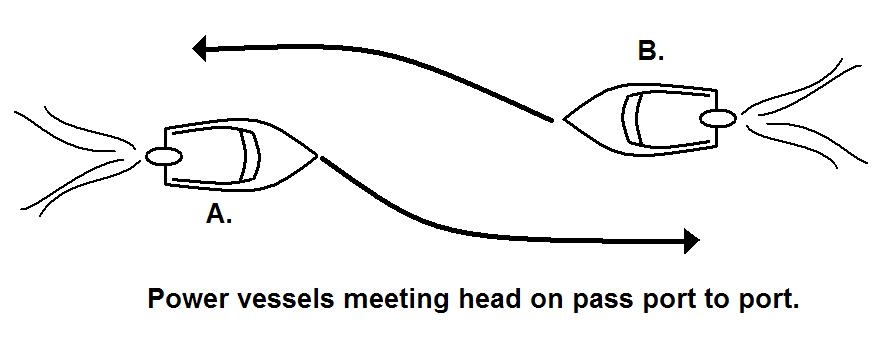
In nautical terms this means that the port side of your boat will pass the port side of the other boat or port-to-port.
In this situation there is no stand-on boat, each boat must give-way and alter it’s course or rate of speed to safely pass.
If you are a sailboat under sail meeting a power boat head on, this rule does not apply. Instead the rule that power boats mus give-way to sailboats applies.
Power Boats Crossing
When two power boats are not meeting head on but their paths cross (like cars meeting at an intersection), the boat on the starboard (right) is the stand-on boat and the boat on the port (left) is the give-way boat.
This, although sounding straightforward, can be confusing when power boats meet at a slight angle (are they meeting head on, are they crossing or is it an overtaking situation?).
A boat is head on when it coming at a direction straight off the bow. To determine if a boat is crossing or overtaking, consider the angle of light from the steaming (masthead) light. Masthead lights shine from straight ahead to a point 22.5 degrees abaft (behind) the beam on either side. If another vessel is within that range, then it is considered a crossing vessel. If the other vessel is more than 22.5 degrees abaft the beam then the other vessel is consider an overtaking vessel.
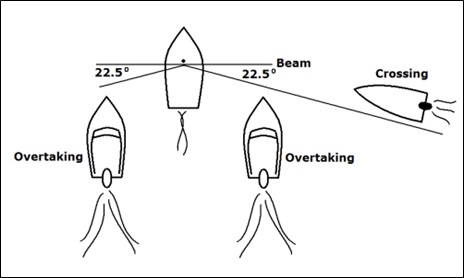
Safety first so never assume that the other boat views the situation the same as you do. If you are unsure of the other vessels intentions, try and raise them on the VHF or sound the danger signal – 5 short blasts.
